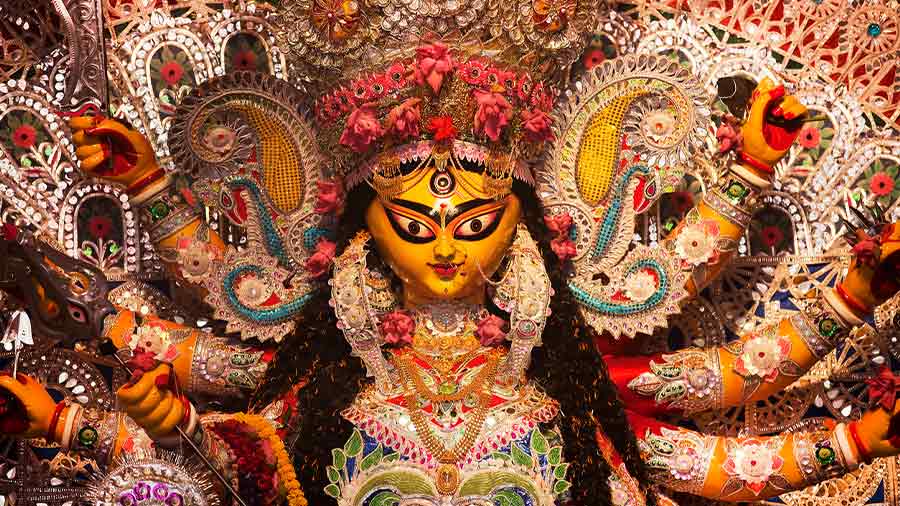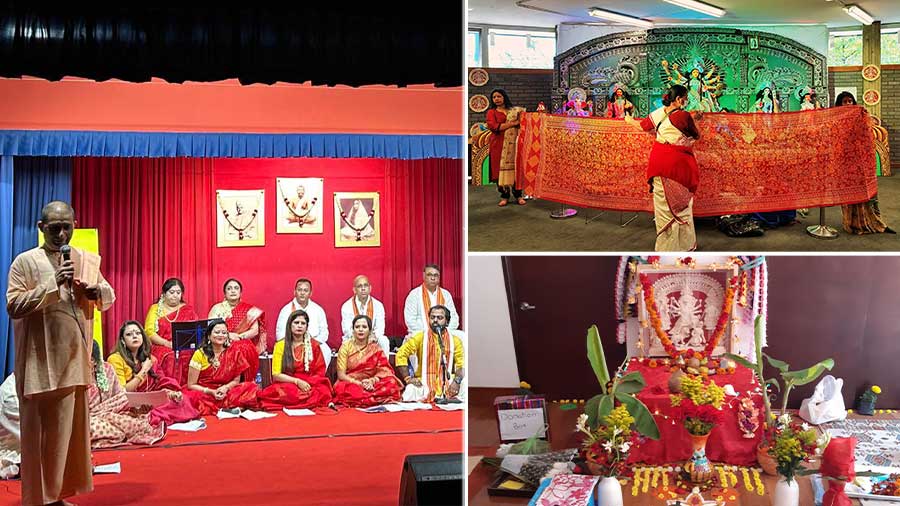The first strains of the sitar filled the room as we gathered at Dr Siddhartha Mukherjee’s elegant New York home. This wasn’t just another concert; it was the official opening of our Durga Puja season here, thousands of miles away from Kolkata. Ustad Ikhlaq Hussain’s melodies swirled around us like autumn leaves caught in a gentle breeze, a signal from one world to another.
Seated among a diverse group of New York’s cultural connoisseurs, each of us an amalgamation of identities and experiences, I felt both near and far. Draped in my white silk kurta with a red border – a piece of Kolkata’s Biswa Bangla I’d tucked into my suitcase – I was transported. Each pluck of the sitar was a whisper, a secret only those who’ve heard the rustle of shiuli flowers back home would understand.
After the sitar’s final note had reverberated and settled into silence, the room erupted into applause, followed by an intimate dinner break. It was then that I felt the absence of Kolkata the most. Compelled, I reached for my phone and began to share videos of this year’s pandals with those around me.
As we watched, New Yorkers gasped and marvelled at the artistry and innovation on display. A pandal made entirely of bamboo and vibrant fabric; another one themed around Sukumar Ray’s beloved Abol Tabol, teeming with whimsy and nostalgia. My eyes widened at a pandal adorned with phuchkas, my favourite street food – a playful nod to the city’s vibrant culinary culture.
These open-air installations, each a blend of tradition and ingenuity, could rival any art exhibit in the Met or MoMA. How I wished I could whisk away the cultured patrons around me to the bustling streets of Kolkata, transformed each year into an awe-inspiring museum under the sky.
Suddenly, we all fell silent. On my screen was an installation unlike any other – a searing comment on sex trafficking. Visitors on their way to the Goddess, had to walk past a hauntingly powerful installation featuring vultures circling broken dolls.
Though we viewed these through a digital screen, the emotional impact was deeply personal and immediate. The room felt smaller, our world suddenly connected by threads of humanity that stretched across oceans.
While my New York celebrations are special in their own right, they can’t fully replicate the magic of being in Kolkata during this time. I will miss late night pandal-hopping with friends, the taste of Kolkata’s street food, the pulsating rhythms of the dhaak, and the collective effervescence that makes the festival unique. The air here lacks the distinct smell of shiuli flowers and the earthy scent that signals the change of season.

‘I will miss late night pandal-hopping with friends, the taste of Kolkata’s street food, the pulsating rhythms of the dhaak, and the collective effervescence that makes the festival unique’ iStock
But I realise, Puja committees in New York have worked tirelessly to bring us a slice of home. Pandals have been erected in borrowed school auditoriums or rented community halls, idols have been flown in or crafted by local artisans, and the assortment of cultural programmes that will accompany the rituals are Rabindranath Tagore and Manna Dey.
There’s a nostalgic tinge to my excitement as I select the pujas I will visit with my friends. A definite is the one that promises a “Dhunuchi dance competition” in Queens, its poster filled with joyful faces lit by the warm glow of burning incense. The Manhattan celebration, featuring an idol crafted by an artisan flown in from Kolkata’s famed Kumartuli, is another one. Another in Brooklyn hints at a cultural melding, offering “phuchka tacos” and performances ranging from Rabindrasangeet to indie bands.
I will attend the ceremonies wearing a velvet kaftan paired with sneakers, taking care not to trip over the fabric as I navigate the city’s concrete labyrinth on my way to the puja venue. And I will serve a smorgasbord of Bengali and American cuisine to my guests, a tapestry of my amalgamated world, and decorate my home with marigold flowers.
The Agomoni songs that will fill my apartment, streaming through Spotify, may not be live, but they capture the essence of the season and remind me that the Goddess’s arrival is universal. It’s a complex emotion, a mix of nostalgia and belonging, of feeling connected across oceans and time zones. And yet, isn’t that what Durga Puja is all about? No matter where we are in the world, we find ways to celebrate, to come together, and to feel that intangible sense of home.

Though it’s a different experience celebrating far from the intoxicating scents and vibrant sounds of Kolkata, the essence of Durga Puja needs no translation. Above, a glimpse of a Durga Puja in Illinois Bhaskar Mondal
Though it’s a different experience celebrating here, far from the intoxicating scents and vibrant sounds of Kolkata, the essence of Durga Puja – of community, faith, and the joy of coming together – needs no translation.
So here I am, making plans and reservations, reminding myself that while the settings might differ, the spirit of the Puja remains the same. Whether in the melodies of a sitar in a New York home, or the rhythmic beats of dhaak in a Kolkata pandal, we find our connections, our community, our sense of belonging.
The sitar might not be the dhaak, and autumn leaves will never be shiuli flowers, but they do herald the same joyous season. And for that, I am grateful.
Happy Durga Puja, wherever you may be.
Ruchira Gupta is an Emmy-winning journalist and founder of the NGO Apne Aap.


